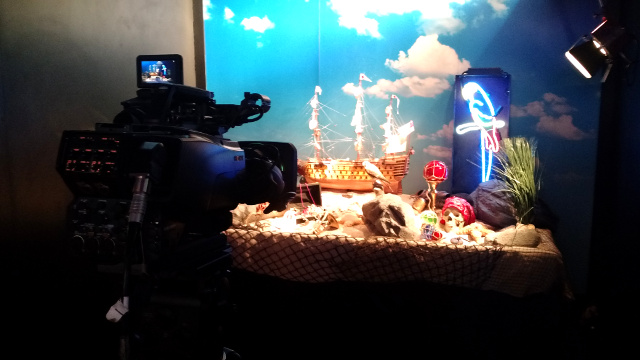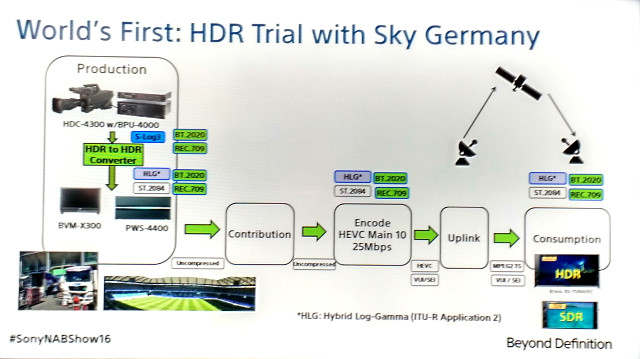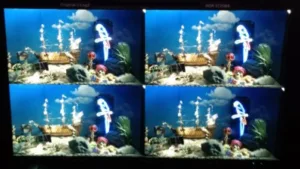Sony has introduced a new HDR monitor, the 55-inch PVM-X550 OLED monitor, which offers quad view display among its other features, and is aimed at client viewing in UltraHD. The monitor will also be available in August for around $27K.
It joins the BVM-X300 30” 4K OLED monitor (although that one is 4096 x 2160 DCI 4K, whereas this one is 2840 x 2160 – Man. Ed.) that was introduced a year ago and has a peak luminance of 1000 cd/m², whereas the X550 has a peak luminance of 400 cd/m². The BVM-X300 was updated as well to add support for both Hybrid Log-Gamma formats (BBC and NHK), safe and aspect markers, XYZ color modulation and 1.5G dual link inputs.
The PVM-X550 offers 12-bit signal processing and supports HDR through various Electro-Optical Transfer Functions (EOTF), such as S-Log3, SMPTE ST.2084 and Hybrid Log-Gamma, covering applications for both cinematography and broadcast. The color gamut is DCI-P3.
The 400 cd/m² peak luminance makes it a little dim for content mastering (and is below the level needed for the UHD Alliance Premium logo), but the quad-view capability is extremely powerful, especially coupled with the way these four sources can be customized. For example, each view can come from a different source (1080 or 4K over HD-SDI or HDMI 2.0a) and is scaled to fit in the 1920×1080 portion of the screen in quad-view mode. Each view can be tailored with its own EOTF. This makes the monitor good for judging luminance grades, but not for color conversions.
Sony set up a live camera capturing a small pirate-themed diorama. The camera captured the scene in HDR using Sony’s S-Log3 OETF curve. Such curves are often developed to suit the particular characteristics of the sensor. The output was shown in quad-view on the new PVM-X550 monitor as shown in the photos below.


In the upper left quadrant, the EOTF is selected to be HDR S-Log3 to get the best match to the captured content. The bottom left quadrant is HDR HLG; the bottom right is SDR 1886 and the upper tight was HDR PQ. This should allow the review of the various EOTFs.
However, Sony’s Hugo Gaglionni pointed out that each of these images is 1920×1080 resolution and that there is no definition of the color space container in HLG for 1080 content. As a result, the bottom left quadrant is displaying in BT 709 colors instead of BT 2020 colors. This was verified by showing the same content on the 30” BVM-X300 monitor in 4K resolution and noticing the color differences.
Sony also showed slides of the workflow for its first HDR UHD trial broadcast in cooperation with Sky Germany and the US Open in America.


Other highlights from Sony’s NAB 2016 booth included:
- HDC-4800 4K 8x ultra high frame rate camera system
- Optical Disc Archive Generation 2, high-performance hardware and media for archive and storage
- PXW-Z450 4K shoulder-mount XDCAM camcorder
- Network Media Interface (NMI) for Sony’s IP Live Production system
- XVS Series Switchers, XVS-7000 and XVS-6000
- Media Backbone Hive
- LMD-B170 17-inch HD LCD monitor
- HXC-FB75 entry level studio camera
- XDCAM Air wireless workflow
- UWP-D Wireless Microphone System, URX-P03D
Analyst Comment
This is an interesting monitor with a panel that we have heard is made by LG, which is no surprise as that company is the only one making production OLEDs of this size. We have also heard that Sony is not using the RGBW structure that LG uses in its TVs. I suspect that the reason for this is that if you have an RGBW panel, there has to be an algorithm to calculate how much white to use and when. In a mastering situation, it’s possible that an effect on the screen might be the result of these algorithms, rather than of the original signal, and that would be unacceptable. By adopting RGB, such problems are avoided. However, there is a downside and that is that you can’t, without WRGB, get to higher brightnesses, at least at the current state of the art. LG Display has shown TV OLED panels at up to 1,000 cd/m² peak brightness, and the UHD Alliance Premium logo mandates a minimum brightness of 540 cd/m², which this monitor cannot reach.
The other issue is that the monitor supports only 3840 x 2160 which means that content that has been captured in DCI 4K must be scaled to be shown. That won’t be popular with some users. Given that Sony is using a custom panel from LG Display, it might have been thought that a DCI 4K display might have been feasible. However, that would have meant changing the size and shape or the backplane quite a lot. That would have cost a lot, for a limited market (at $27K). (BR)

